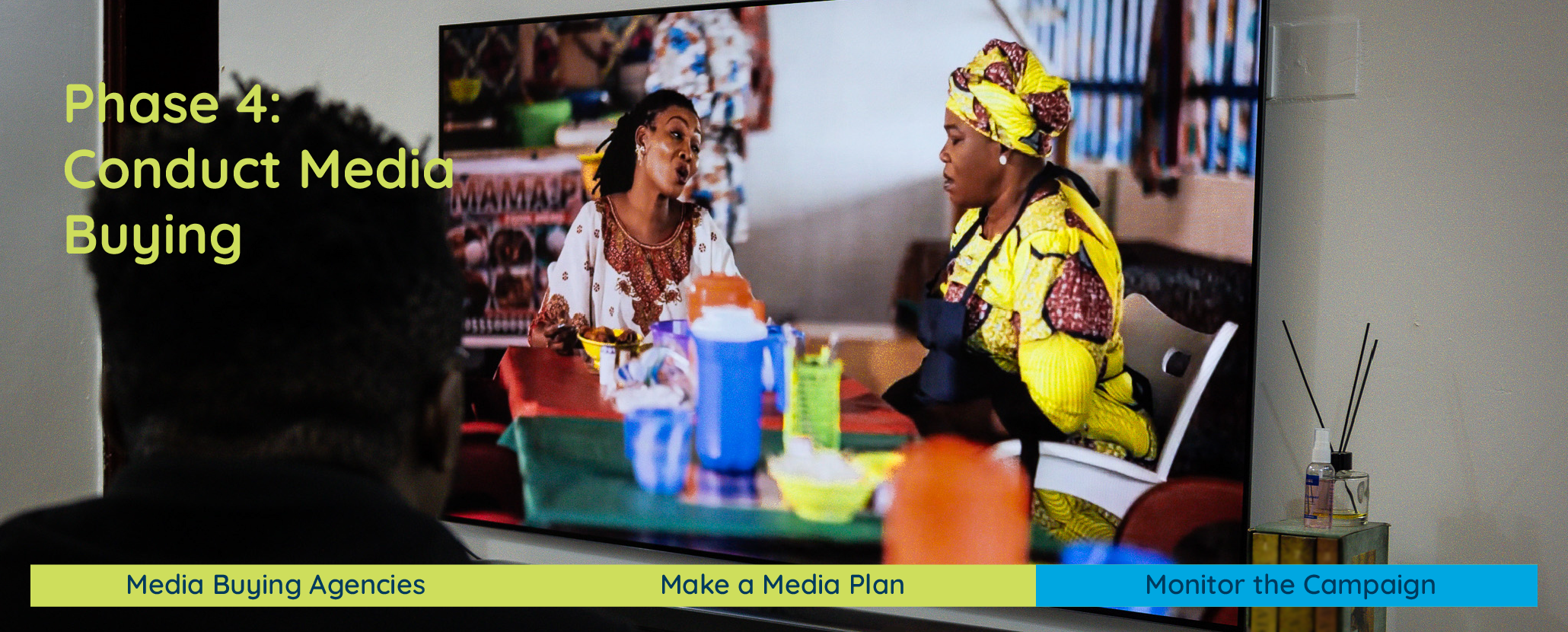Monitor the Campaign

Media buying is the process of developing a media plan, deploying that plan to media houses like radio and TV stations, and monitoring their compliance to the media plan before making payment.
Monitor the Campaign
How do we know the campaign aired?
By the end of this step, you will have set up a system for monitoring the media house’s adherence to the media plan.
How to conduct this step and achieve its main objectives:
Contract a Media Monitoring Agency
A media monitoring agency records all broadcasts from selected media houses and can detect when specific spots air using special software. This service is useful for checking station adherence to the media plan and as supporting documentation when making payments. Using these recordings, the media monitoring agency can offer evidence in the event of a dispute with the media house about whether or when content aired.
Request for a Media Monitoring Agency Proposal
Suggested time:
60 days
Participants:
Core Design Group and Admin & Finance Team
Example: Request for a Media Monitoring Agency Proposal
This example of a request for proposal for a media monitoring agency can be adapted for your context and includes a template for evaluating submissions. You may need to contract more than one media monitoring agency to ensure your entire broadcast area is covered.
Effort required:

Recruit Independent Media Monitors
A media monitoring agency is the ideal method for monitoring compliance given their ability to record broadcasts and detect when your spots air. However, these agencies may not cover your entire campaign area, especially if your intended audience is in rural, hard-to-reach areas. In this case, an alternative would be to use independent media monitors, who are consultants you recruit and train to ensure radio, TV, and other outlets adhere to your media plan, including the number and time of campaign broadcasts. Although more labor intensive than using a media monitoring agency, independent media monitors ensure your broadcasts air as agreed and provide supporting documentation for verifying if payment is warranted. A single independent media monitor would not be able to monitor more than one radio station at a time or more than three campaigns per station. Therefore, a monitor is required for every radio station not covered by a media monitoring agency.
Training and Reporting Formats
Suggested time:
2 days for training
Participants:
Media buying team
Example: Training and Reporting Formats
This training package for independent media monitors includes tools for tracking campaign broadcasts at assigned outlets (e.g., radio or TV stations).
Effort required:

Compliance Reporting
If you use a media monitoring agency, ask them to submit a consolidated compliance report that covers all stations they monitor. If you hire independent media monitors, they should submit reports for their individual stations, which need to be reviewed for accuracy and completeness. You may also need to hire a local supervisor to review their reports and coach them on how to improve the quality of their reporting.
A consolidated monitoring report covering all stations should be prepared monthly to track compliance performance data over time. If media buying is performed in-house, then staff should be in regular contact with the stations to follow up on their adherence to the media plan, especially stations with a track record of poor performance.
Reports from independent media monitors should be regularly reviewed to verify their accuracy and completeness and to prevent fraud. In one case, a monitor failed to check their assigned station themselves and instead used the station’s logs. The fraud was discovered because the station’s typical low compliance suddenly improved significantly. Stations also may dispute compliance reports from the media monitoring agency and request a verification, which requires the agency to manually review their recordings instead of relying on software to identify when a spot aired. The stations may present their own record of what aired and when (e.g., certificate of transmission or logbooks), but these records can be manipulated and should only be used as a last resort.
An independent media monitor’s report cannot be backchecked as they do not keep recordings of the station. If a station contests the report, you can request the station’s logs to compare against the independent media monitor’s report. Stations that maintain digital logs are typically more reliable than those that keep manual logs. In one case, a media monitoring agency reported a station as off-air for an entire month, but the station insisted they were on the air. When a second media monitoring agency performed a backcheck, it found that the station had in fact aired the spots and that the first media monitoring agency had experienced technical problems in its monitoring.
Compliance Monitoring Reports
Suggested time: 1 day for state report, 1 week for consolidated report
Participants: Media buying team; independent media monitors; state-level research, monitoring, evaluation, and learning team
Example: Compliance Monitoring Reports
This example shows a one-month monitoring report to be submitted by a media monitoring agency or state-level consolidated independent media monitor report. A monthly consolidated compliance report also is included. It shows performance over time for all stations airing a campaign. Generally, 70% is considered the minimum acceptable compliance, but you may set your own targets.
Effort required:

Measure for Impact
Now that your campaign is in full swing, you need to focus on two primary areas of interest for assessing progress:
- Exposure: What proportion of people have been exposed to your campaign and how frequently (e.g., classified by campaign channels, geographic regions, and demographics)? Measuring whether your intended audience is sufficiently exposed will confirm appropriate selection of channels, stations, and time slots.
- Change in determinants and behavior: Are people exposed to your campaign showing improved determinants and behaviors? Comparing people who report campaign exposure with those who report no exposure is a common way to measure a campaign’s impact. You should measure the focal determinants and behaviors of the campaign, as identified in your creative brief. You might also consider measuring how well the campaign resonates with the intended audience. Dose response is the relationship between the amount of exposure (the dose) and the resulting changes on determinants and behavior (the response). By measuring the frequency of exposure to the campaign, you can also measure dose response to gauge campaign effectiveness.
Both measurements require quantitative analysis. It is beyond the scope of this toolkit to provide you with the tools to conduct a quantitative study. You should work with your RMEL unit to plan and design a quantitative study that measures campaign exposure and its correlations, if any, with changes in determinants and behavior. Depending on your time, budget, and research questions, you might consider using an omnibus study or household survey.
An omnibus research survey collects data on multiple topics or issues using a single questionnaire, which allows researchers to gather diverse information efficiently. This approach is often used in market research to provide a comprehensive overview of consumer attitudes, behaviors, or preferences without the need for separate studies for each subject. An omnibus study offers quick results for significantly less effort and cost than a household survey. However, the statistical analysis that can be performed on a dataset from an omnibus study is limited.
A household survey collects data from individuals or families on various topics, such as demographics, income, health, and living conditions. These surveys are conducted through interviews based on in-depth questionnaires to allow for more in-depth statistical analysis than an omnibus survey. The turnaround time and budget for household surveys are typically longer and more expensive than that of an omnibus study.


